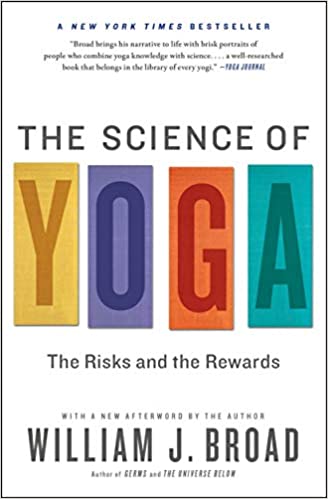I just finished reading William J. Broad’s The Science of Yoga: The Risks and the Rewards and overall, I thoroughly enjoyed it. Broad’s style of writing is exciting, sophisticated yet accessible, and his insights and anecdotes are enticing. Not only is the book one that is absolutely full of yoga-related information, (history, philosophy, fitness) but it is also a genuinely good read. I felt that the writer had a strong voice, so strong in fact that it seemed as though I was listening to a series of anecdotes and insights beside a fireplace as I read through it. Broad’s strength as a researcher, reporter, yogi and narrator all make the book believable and, at times, hard to put down.
William J. Broad is an experienced reporter and yogi who has written many research-based books on topics that interest him. His most recent is about a long standing hobby and past-time of his, yoga. Broad divides his book into seven chapters and uses them to categorize the various broad questions and commentaries that are often associated with practicing yoga. The topics/titles are: Health, Fit Perfection, Moods, Risk of Injury, Healing, Divine Sex, and Muse. It was the variety of topics that attracted me to the book in the first place, and confirm for me that this is a great first time yoga-lit venture.
I’ve glanced at and flipped through a lot of yoga books but I hadn’t decided to go through one cover-to-cover until I came across The Science of Yoga. It seems that the reason for my reluctance to read other books in the past stemmed from an uneasiness I have about yoga-centric conventional wisdom that doesn’t always come from a place of thorough research. I didn’t want to read 300 pages in which I hear nothing but praise and a long list of benefits about practicing yoga with very little evidence. Sweeping comments and generalizations are a major problem in the yoga world. This problem in discourse is taken to task in Broad’s book and his resultant deconstruction is refreshing to say the least.
Broad, for the most part, is hesitant to make any comment without it stemming from some sort of research. Author opinions are unavoidably present in literature, but Broad is carefully objective throughout. He seems to eliminate yoga hearsay and dodgy conventional wisdom from every point he makes. There is no doubt that this is done consciously; in his prologue Broad states: “This book cuts through the confusion that surrounds modern yoga and describes what science tells us”. Broad also reminds his readers that, in spite of its popularity throughout North America, Yoga has no official governing body. The closest thing yoga has to regulation in the US and Canada is The Yoga Alliance, but there is no state authority to ensure that the organization operates to a certain standard. The author, throughout his five years of in-depth research for the book, attempts to answer why a practice that is so popular and seemingly beneficial, has not cut through to a higher level of regulation, research and education. It’s as if much of yoga’s existence is some how unofficial.
I am not going to list Broad’s findings in detail. But overall, it appears that yoga’s rewards outweigh its risks which would explain why so many of us our absolutely hooked on it. In his epilogue, Broad argues that the healing benefits of yoga should propel it forward in the medical world as an inexpensive, easy and accessible form of physical therapy and health management.
Broad’s insight on yoga as an activity to keep physically fit ultimately concluded that yoga alone is not an adequate source of cardiovascular exercise, can actually decrease metabolism and is not a good stand-alone weight-loss regimen. His research shows that cross-training, or participating in a variety of physical activity, will be the best benefit to physical fitness. My main issue with this chapter was that Broad chose to zero in on oxygen uptake as a means to measure yoga’s merit as a fitness regime. He failed to highlight that strength, stability and flexibility training are all part of a complete fitness regime. I think the author may have been so set on deconstructing the notion that yoga is a complete workout, that he ended up omitting the physical and athletic benefits that it does possess. I believe this is part of the problem of fitness-related discourse in the Western world. We tend to think of fitness as all or nothing; either you’re an athlete or you’re a couch-potato. Remember that some physical activity is always more than zero, and that fitness isn’t always about getting your heart rate up.
Overall, I suggest you read this book if you want a general understanding of the history and science that are associated with practicing yoga. Not only does Broad provide a unique and thorough perspective, he also keeps the reader entertained with his snappy yet calmly professional writing style. As with any book, I suggest you not take every point that it makes to heart; the book is mostly a series of anecdotes, so automatically we know there is more behind each story. If you read the book, read it as research, not as self-help, and you will gain valuable information on the vast concepts that surround your practice.
Photo by Franki Chamaki on Unsplash


